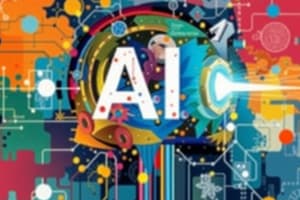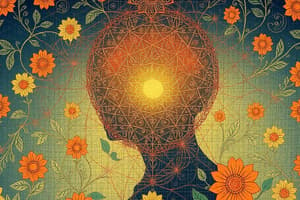Podcast
Questions and Answers
What is the significance of the Turing Test in the history of AI?
What is the significance of the Turing Test in the history of AI?
The Turing Test measures a machine's ability to exhibit intelligent behavior indistinguishable from a human, marking an early benchmark for AI.
Who created the first industrial robot, Unimate, and what was its primary function?
Who created the first industrial robot, Unimate, and what was its primary function?
Unimate was created by George Devol and was primarily used for performing repetitive tasks in manufacturing, such as welding.
Describe the impact of Eliza on the development of conversational agents.
Describe the impact of Eliza on the development of conversational agents.
Eliza, developed by Joseph Weizenbaum in the 1960s, demonstrated the potential for machines to simulate human-like conversation and laid the groundwork for future chatbots.
What innovations did IBM Watson bring to AI, particularly in its famous match on 'Jeopardy!'?
What innovations did IBM Watson bring to AI, particularly in its famous match on 'Jeopardy!'?
How have advancements in AI, such as Stable Diffusion and Midjourney, transformed creative processes?
How have advancements in AI, such as Stable Diffusion and Midjourney, transformed creative processes?
How did Shakey the robot contribute to the field of robotics?
How did Shakey the robot contribute to the field of robotics?
In what ways did AIBO change public perception of robots?
In what ways did AIBO change public perception of robots?
What role did ChatGPT play in advancing conversational AI?
What role did ChatGPT play in advancing conversational AI?
What are the key features of Siri that distinguish it from earlier AI systems like Eliza?
What are the key features of Siri that distinguish it from earlier AI systems like Eliza?
Explain how IBM Watson's technology differs from traditional AI methods.
Explain how IBM Watson's technology differs from traditional AI methods.
Flashcards are hidden until you start studying
Study Notes
Foundations of Artificial Intelligence
- Turing Test: Proposed by Alan Turing in 1950, a measure for machine intelligence where a machine's ability to exhibit intelligent behavior indistinguishable from a human is tested through conversation.
- Birth of AI: AI research began in the mid-20th century, particularly during the 1956 Dartmouth Conference, which is regarded as the official start of AI as a field.
Early Innovations in AI
- Unimate: The first industrial robot developed in the 1960s, which revolutionized manufacturing by automating repetitive tasks in assembly lines.
- Eliza: Created in the 1960s, an early natural language processing program designed to simulate conversation, mimicking a psychotherapist and showcasing basic AI's potential for human-like interaction.
- Shakey: Developed in the 1960s, the first general-purpose mobile robot that could reason about its actions and navigate its environment using sensors and planning.
Developments in Robotics and Virtual Assistants
- AIBO: Launched in 1999 by Sony, a robotic pet that could learn and interact with its environment, highlighting advancements in AI for consumer products.
- Roomba: Introduced in 2002 by iRobot, a robotic vacuum cleaner that utilized AI algorithms for efficient cleaning and navigation in homes.
Modern AI Assistants and Social Robots
- Siri: Developed by Apple and introduced in 2011, one of the first widely used virtual assistants, capable of voice recognition and performing tasks based on user commands.
- Sophia: Unveiled in 2016 by Hanson Robotics, a social humanoid robot known for its lifelike appearance and ability to converse on various topics, representing advancements in AI and robotics as public figures.
Advanced AI Systems and Generative Models
- ChatGPT: A conversational AI model developed by OpenAI, based on the GPT architecture, capable of generating human-like text and performing various language tasks.
- Gemini: A powerful AI developed by Google DeepMind, designed to achieve advanced reasoning and understanding in multiple domains.
- IBM Watson: Known for competing in the game show "Jeopardy!" in 2011, this AI system uses natural language processing and machine learning to analyze vast amounts of data and generate insights.
Generative AI in Visual Arts
- Stable Diffusion: A generative model released in 2022 that creates high-quality images from text prompts, showcasing the potential of AI in art and design.
- Midjourney: Another AI image generator emphasizing artistic creation, allowing users to produce imaginative visuals from descriptive text, further demonstrating the growth of AI's role in creative fields.
Studying That Suits You
Use AI to generate personalized quizzes and flashcards to suit your learning preferences.




